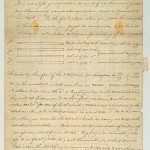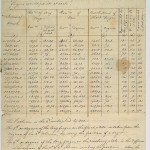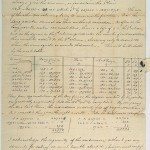Letter from Charles Bage to William Strutt,1816/06
My Dear Sir
I do confess that you have puzzled me exceedingly; but I mean to be revenged and completely. It is no slight gratification to me to find that much greater men than myself can make mistakes, and so I proceed to my task. In the first place when you wrote the description of the instruments you forgot its construction and in the next place your calculation and theorem for reading off are incorrect.
1st Back wheel 149 teeth connected with short finger
Wheel of 150 teeth }
2nd } connected with long finger
Wheel of 151 dç }
3rd Wheel of 150 I Ä connected with revolving face
The velocity therefore of the 3 motions are as 150 / 149 and 151 / 150
Or in the smallest whole numbers as 22500, 22350 and 22499. It follows that when the 2nd or long fingers has made 22350 revolutions they will all become round to their first position, and as the winch makes 300 revolutions for one of the 2nd wheel; 22350 x 300 = 670500 is the whole number and not 6750000 as you state. As to the construction, you describe the 2 front wheels as having 150 and 149 teeth which is a mistake. And now as to your mode of reading off. You assume short finger at 148, long finger on moveable plate 93 and on fixed plate 76; and the result you make 4.468052. Now when the short finger comes up to 150 only 2 more than you have assumed, the whole circle of 6705000 is completed, and therefore it is obvious your result is too little.
My theorem is 148 x 44700 = ÄÄÄÄÄÄÄÄÄÄÄÄÄÄÄÄ6615600
__________
148 + 93 _ 150 x 300 = ÄÄÄÄÄÄÄÄÄÄÄÄ. 27300
76 x 2 ÄÄÄÄÄÄÄÄÄÄÄÄÄÄÄÄÄÄÄÄ.. 152
_________
The real number of turns of the winch 6 643052
_________
If I had not given you trouble enough already, I would have left it to you to search into the truth of this theorem. However I will give you about the hundredth part of the figures I have made on the occasion, for I severely ever remember to have been so puzzled with motions so apparently simple Ä In the following table I have divided the whole –circle of associated motions” into 16 equal parts, in order to shew how the fingers would point at each.
Turns of Winch Revolutions of Long Finger Revolutions of Face Revolutions of Short Finger Degrees
Marked
By
Long
Finger
On
Fixed
Plate Dç on
Move-
Able
Plate Degrees
Marked
By
Short
Finger
Turns of Winch
1 Revêns
2 Degrees 150 to the circle Revêns
3 Degrees Revêns
4 Degrees
5
6
7
419062.5 1396 131,25 1406 28,125 1406 37,5 131 46 9
838125 2793 112,5 2812 56,250 2812 75, 112 93 18
1257187.5 4190 93,75 4218 84,375 4218 112,5 93 140 28
1676250 5587 75, 5624 112,5 5625 0 75 37 37
2095312,5 6984 56,25 7030 140,625 7031 37,50 56 84 46
2514375 8381 37,5 8437 14,75 8437 75, 37 131 56
2933437.5 9778 18,75 9843 46,875 9843 112,5 18 28 65
3352500 11175 0. 11249 75, 11250 0 0 75 75
3771562,5 12571 131,25 12655 103,125 12656 37,5 131 121 84
4190625 13968 112,5 14061 131,25 14062 75 112 18 93
4609687.5 15365 93,75 15468 9,375 15468 112,5 93 65 103
5028750 16762 75, 16874 37,5 16875 0 75 112 112
5447812.5 18159 56,25 18280 65,625 18281 37,5 56 9 121
5866875 19556 37,5 19686 93,75 19687 75 37 56 131
6285937.5 20953 18,75 21092 121,875 21093 112,5 18 103 140
6705000 22350 0. 22499 0. 22500 0 0 0 150
The 1st column is the 2nd multiplied by 300
The 5th or degrees of the long finger on the fixed plate is taken from the degrees of the 2nd column, omitting the fraction of a degree.
The 6th or degrees of the long finger on the revolving plate is the difference of the degrees of the 3rd and 2nd column, sinking the fractions. Where the number is less in the 3rd than the 2nd, 150 is added to the former.
Thus in the first line 28,125 + 150 _ 131,25 = 46,875. Therefore the finger points to 46.
The 7th is the difference of degrees between the 4th and 3rd _ fraction omitted.
To prove the 1st line 9 x 44700ÄÄÄÄÄÄ= 402,300
46 + 9 = 55 x 300 = Ä.. 16500
Fifth column doubled Ä 262 _________
419062
Prove the 8th Ä 75 x 44700 = 3352500
75 + 75 _ 150 = 0 x 300 = Ä 0
5th column Ä 0
_______
3352500
_______
And so of the rest
It is obvious that the difference between the 3 and 4th columns provided the fractions are taken, multiplied by 44700 would always give the answer, as for instance the 3rd line.
112,5 _ 84,375 = 28.125 which xêd by 447000 = 1257187,5. The use of the other two columns being to measure the fraction. Now the long pointer cannot do this without correction. As often as the long pointer makes 150 revolutions, there is a loss of 1in the 6th column; and as the degrees in the 7th column indicates the number of such revolutions, they must be added to the 6th column; observing only to deduct 150 when the sum equals or exceeds that number. This will be illustrated by the next table.
Winch
1 Long Finger
2 Face
3 Short Finger
4 LF
5 LF
6 LF
7
447 149–0 149 – 149 150 – 0, 0 149 1
4475 875 149”27,9375 150”27,12375 150”28,125 27 149 1
44811,750 149”55,875 150”55,2475 150”56,25 55 149 1
44867,625 149”83,8125 150”83,37125 150”84,375 83 149 1
44923,5 149”111,75 150”111,495 150”112,5 111 149 1
44979,375 149”139,6875 150”139,61875 150”140,625 139 149 1
45035,25 150”17,625 151”17,7425 151”18,75 17 0 1
Thus from 149 revolutions of the long fingers, the degrees marked by the pointers are gradually augmenting, till the 150th revolution is completed. By comparing the two last lines, the indications suddenly fall off and require corrections.
But corrected they give the right result: Take the last lines as examples
1 x 44700 = 44700 1 x 44700 = 44700
149+1 = 150-150=0 x 300= 0 1 + 0 = 1 x 300 = 300
139 x 2 = 278 17 x 2 = 34
_____ _____
44978 45034
I acknowledge the ingenuity of the contrivance and thank you very sincerely for taking so much trouble about it; but you must confess you did not complete the theory. At one time I thought it impossible to make it answer and had nearly written a letter to you to prove it. Will you have the goodness to desire Mr Whitehurst to send me his account? _
Mrs Bage desires to present her best respects to you and the young ladies with Dear Sir yours sincerely
Charles Bage








